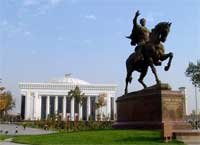
Becoming an integral part of the national suit, the skullcap became a tradition of Uzbek people. And despite that everything is changing in the whirl of time, it remains untouched in memory of the ancestors, who knew how to treasure the beauty in all its forms.
The Uzbek skullcap, small hard of soft backed hat always was one of the most popular types of national applied art of the Republic. The history of skullcap as headwear goes deep into centuries. Pattern forms of its embroideries show the long way of development of this art. Headwear reminiscent of skullcaps can be found in sculpture, mural painting, terracotta figuring and oriental miniature of 15-16 centuries. The culminating moment in development of skullcap workmanship as a type of national costume art was the end of 19th and middle of 20th century, when skullcap became a part of art and aesthetics. And today skullcap making became a real art.
However, a skullcap is not just a headwear, but one of the most amazing traditions of Uzbek people. Both a mischievous child and a man of wisdom will be glad to have one. Even the ardent fashionistas would not mind of wearing it. And there are sayings: “Intellect, honor and conscience of a man lay in his skullcap”, “Skullcap is not a burden for a man”. Friendly attitude of people to this small cap is reflected in the wisdom: “When there is no one to talk to – talk to the skullcap”.
There is a lot of interesting in the skullcap, for example, the process of cap making. It is made of two or several layers of fabric quilted and fixed by a silk or cotton thread. The made fabric is embroidered by a silk, gold or silver thread. But it is more important who will wear this amazing cap: a man of woman, a child or aged man. Basing on this the fabric, shape, pattern and ornament are chosen. So, black satin or velvet is chosen for men. Women skullcaps are made of silk, velvet and brocade. They can have high or low ledge, can be dressed by single-color or large-tonnage edging from other fabrics, embroidered in silk, bead, thread, bugles and staff beads. An ordinary man may not see these differences, but a competent person will never wear somebody else’s cap.
The most interesting is that it is possible to learn where the cap was made by the technique used in its making, because being made in different regions they distinguish with shape, pattern and range of colors. The following are historically established regional groups of skullcaps: Tashkent, Samarkand, Bukhara, Kashkadarya, Surkhandarya and Khoresm groups, including Ferghana men’s caps. Each region has its own style passed from one generation to another, from a mother to a daughter. Each cap is full of national symbolism. The prevailing pattern for skullcaps is capsicum, which symbolizes purity and estrangement of everything in the world, birds motif means high wisdom, rose branch represents peace and beauty, and also many others. The muslim caps are embroidered in satin stitch, small cross-stitch “iroki”, special stitch “basma” and beads. At the same time good hands do not draw a preliminary sketch, but create a pattern in the process.
Chust’s skullcap of the Ferghana Valley, duppi is very popular among men for its contrast. White patterns of four capsicums on the black background – “qalampir”. According to the legend four flowers on top of the cap protect health of the owner, and sixteen small figures embroidered round the edges of duppi represent the wish to be a big and friendly family and to have sixteen children.
There are other types of the Uzbek skullcaps– Samarkand’s “piltaduzi”, Urgut’s “qalpoq”, Shakhrisabz’s “gilam duppi”, Kitab’s and Shakhrisabz’s “sanama” and “chizma”. “Tah’ia”, “tayha”, “chumakli”, “kush” – Khoresm’s skullcaps for men and women.
Bukhara’s gold threaded cap is very original. It can have round or tetrahedral shape, with vegetable or geometric pattern, covered by fringe and colorful tassels, and the gold threads give the cap solemnity. For this reason, these caps were a constant part of emirs’ and noble people’s costumes, and nowadays are used in wedding dresses…
Today skullcaps of Uzbekistan are popular worldwide. Created by skillful hands, they decorate expositions of many museums. The best collections of the Uzbek skullcaps are kept in Tashkent State Museums of History, Art and Applied Art of Uzbekistan.
Facts – Traditional form of the Uzbek skullcap is four-sided, but peaked, cone-shaped, hemispherical, round and domical skullcaps are found as well.

























